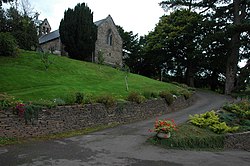Clodock

Clodock Welsh: Clydog is a village in the west of Herefordshire, England. It lies on the River Monnow in the foothills of the Black Mountains, close to the border with Wales. The village is in the civil parish of Longtown. Before 1536 Clodock was in the marcher lordship of Ewyas Lacy. Until 1866 it was a large parish (until 1852 in the diocese of St David's), which included the chapelries of Craswall, Llanveynoe, Longtown and Newton. In 1866 each chapelry became a separate civil parish, and the village of Clodock became part of the civil parish of Longtown.The parish church is dedicated to St Clydog, king of Ewyas, who was killed during the 6th century. The present church dates from the 12th century, and is a Grade 1 Listed Building. It is completely un-Victorianised, with west gallery, box-pews, three-decker pulpit and seventeenth century sanctuary furniture.
Excerpt from the Wikipedia article Clodock (License: CC BY-SA 3.0, Authors, Images).Clodock
Geographical coordinates (GPS) Address Nearby Places Show on map
Geographical coordinates (GPS)
| Latitude | Longitude |
|---|---|
| N 51.941944444444 ° | E -2.9822222222222 ° |
Address
HR2 0PB , Crucorney
England, United Kingdom
Open on Google Maps










